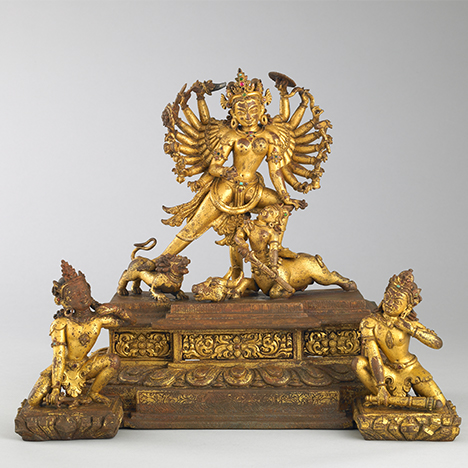
Practiced for centuries, yoga has a long history in the Himalayas and surrounding regions. While in the West yoga is often presented as a mostly physical practice, the yogic tradition contains a lot more than poses and stretches. Yoga is a system of philosophy and practice that seeks to help people align their body and mind in order to transform their experience. One translation of yoga is “yoke,” the tool used to connect an ox to a plough. Like yoga, the art objects in our collection, intended for ritual purposes as well as aesthetic ones, seek to link the worldly and the transcendent. Below are a few pieces from the Rubin Museum’s collection exploring yoga and its connection to mantra, art, and Buddhist deities.
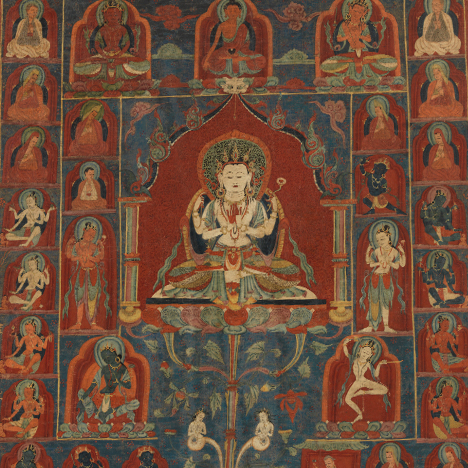
Avalokiteshvara and the most common Buddhist mantra
One yogic practice found extensively in the Himalayas is the use of mantras. Mantras are strings of syllables that invoke the power and presence of a deity. Essentially, the mantra is the deity in sound form. The most common mantra found in the Himalayas is that of Avalokiteshvara, the bodhisattva of compassion. Almost anywhere you go, you’ll find his mantra, “Om Mani Padme Hum,” written or recited again and again, bringing Avalokiteshvara’s compassion into our realm.
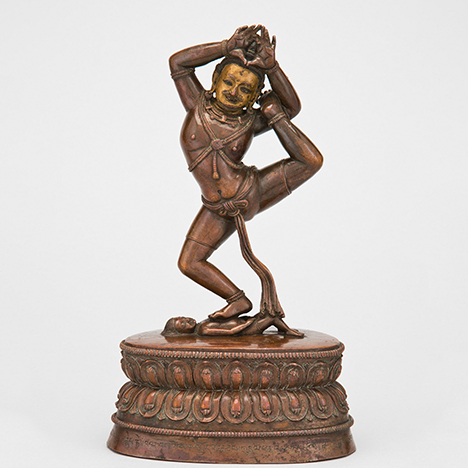
Mahasiddha Jalandhara, the Net Holder; Tibet; ca. 16th century; copper alloy; Rubin Museum of Art; C2003.13.4 (HAR 65218)
Yoga Poses in Classic Traditional Works of Art
Of course, you’ll find a variety of yoga poses depicted in the art at the Rubin. Above is the yogi Jalandhara, who is important in both Hindu and Buddhist yogic traditions. If you’ve ever performed the Jalandhara Bandha, or chin lock, in your yoga class, he is the namesake for the pose.
Need inspiration for your warrior pose? Look no further than this incredible sculpture of the fiercely powerful goddess Durga, one of the jewels of the Rubin’s collection. The pose implies action and movement, two things this static sculpture conveys incredibly well. The sculpture depicts Durga slaying Mahishasura, a demon in the form of a buffalo that has been terrorizing the world. Though it’s no longer in her hand, this sculpture originally depicted Durga holding a spear and stabbing Mahisha in the heart. The warrior indeed!
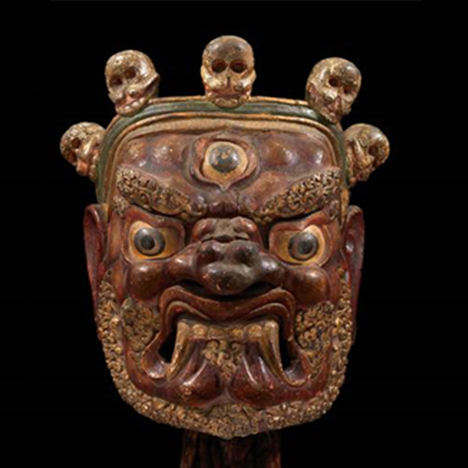
Dorje Drolo, One of the Eight Manifestations of Padmasambhava; Bhutan; ca. 19th century; papier-mâché, polychrome, fabric; Courtesy of Bruce Miller Collection; L2016.1.1
Tantric Yoga Practice
Sure, the Museum has a lot of paintings and sculptures, but what about other forms of art in Himalayas? This mask is used for a unique style of dance known as cham performed at many monasteries throughout the Himalayas. Cham is not just a performance but also a religious expression stemming from the tantric yoga tradition. The mask depicts Dorje Drolo, a wrathful form of the great Indian tantric master Padmasambhava. In addition to establishing Buddhism in Tibet, Padmasambhava brought this tradition of ritual dances, which help purify the land and subdue spirits that could cause harm. To this day cham serves as a way for the community to gather together and enjoy a performance. During these dances, monasteries often put out large tapestries for the public to see, which combine with the music and dance to make a truly multimedia experience! Below is an example of such a tapestry, which is included in the Rubin’s exhibition The Second Buddha: Master of Time.
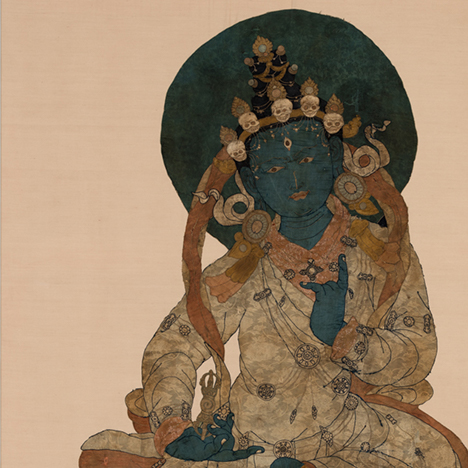
See these artworks on your next visit to the Rubin, or book a private yoga event for you and your friends or colleagues.
Support for The Second Buddha: Master of Time is made possible in part by Bob and Lois Baylis, The Ellen Bayard Weedon Foundation, E. Rhodes and Leona B. Carpenter Foundation, Barbara Bowman, Lisina M. Hoch, and contributors to the 2018 Exhibitions Fund.
The Second Buddha: Master of Time is organized by the Rubin Museum of Art and the Frances Young Tang Teaching Museum at Skidmore College.

